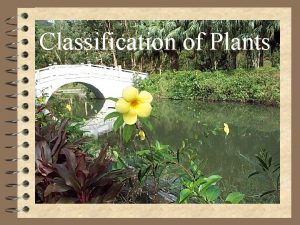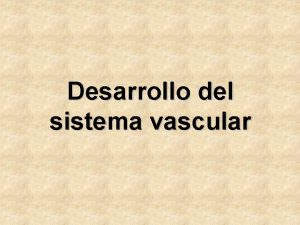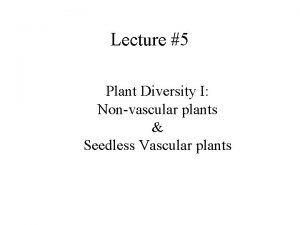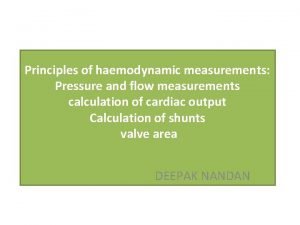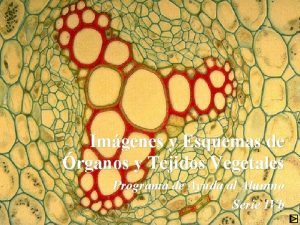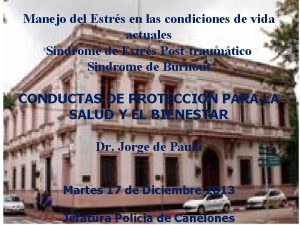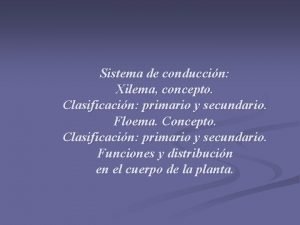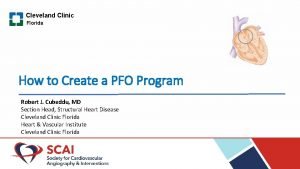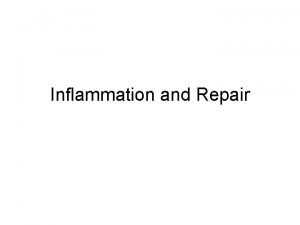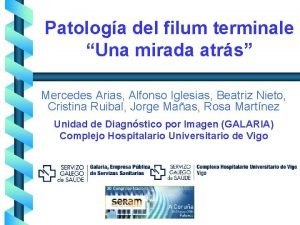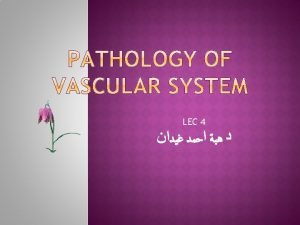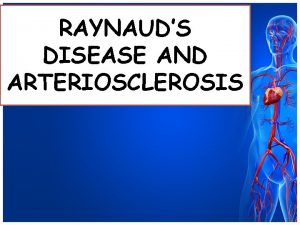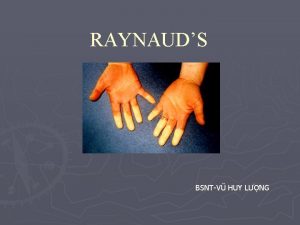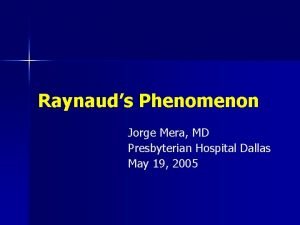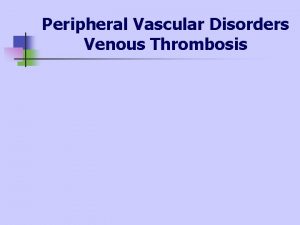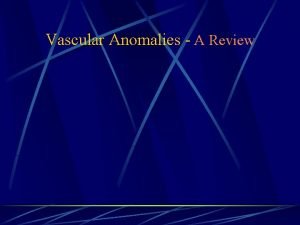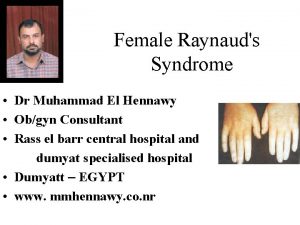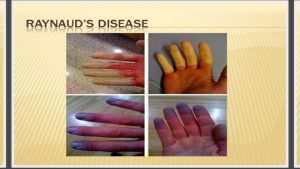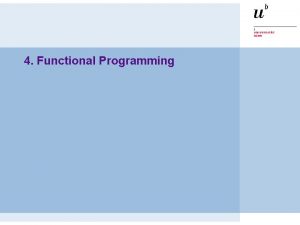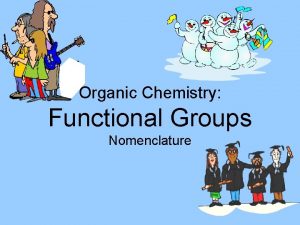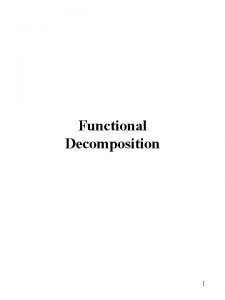1 Functional vascular disorders Raynauds phenomenon 2 Raynauds


























- Slides: 26

1

Functional vascular disorders Raynaud’s phenomenon 2

Raynaud’s phenomenon • Refers to – Intermittent , bilateral attacks of ischemia of the fingers or toes, and sometimes ears or nose. • It clinically manifests as: – Pallor (blanching) followed by cynosis (blue) followed by redness – Occurs following exposure to cold and then rewarming. – Sometimes attacks precipitated by emotional stimuli. • Reflects – Spasm of local small arteries or arterioles. 3

• Classified into two categories: 1. Idiopathic Raynaud’s phenomenon or Raynaud’s disease 2. Secondary Raynaud’s phenomenon 4

Idiopathic Raynaud’s phenomenon or Raynaud’s disease • Occurs as an isolated disorder. • Typically occurs in young, otherwise healthy women. • Of uncertain etiology, it reflects exaggerated vasomotor response to cold or emotion causing vasoconstriction. • Fingers and toes become white blue when exposed to cold. • On warming , they turn red. 5

Secondary Raynaud’s phenomenon • Occurs as a part of a number of systemic disease of connective tissue etc. • Secondary causes include: – Systemic sclerosis (Scleroderma) ** • MC initial manifestation. – CREST syndrome – Systemic lupus erythethomatosus (SLE)** – Thromboangitis obliterans (TAO) – Ergot poisoning (vasoconstriction) – Cryglobulinemia ( patients with RA or HCV) 6

7

Secondary Raynaud’s phenomenon • Clinical: – Cold temperatures and stress are stimuli that may trigger the color changes of the fingers white blue red – Ears and nose cyanotic – Often relived by warmth. • Vessel changes: – Normal initially – Later – show thickening of intima and hypertrophy of tunica media 8

Hypertension • Defined as systolic blood pressure >140 mm Hg and diastolic blood pressure >90 mm Hg for a sustained period. • Hypertension predisposes to development of: 1. Coronary artery disease 2. Cerbro-vascular accidents 3. Cardiac hypertrophy heart failure 4. Aortic dissection 5. Renal failure 9

Pathophysiology of HT • Blood pressure (BP) = Cardiac output (CO) X Total peripheral resistance (TPR). • Cardiac output (CO ) is dependent upon – blood volume (equates with sodium homeostasis) – force of contraction and – Heart rate. • Total peripheral resistance: – Vasodilation: decreases TPR – Vasoconstriction : increases TPR. 10

Role of kidney in regulating BP • The renin-angiotensin-aldosterone system. – Renin (from JGC) converts plasma angiotensinogen into angiotensin I. – Angiotensin I converted into Angiotensin II by ACE. – Angiotensin II increases BP by: • Increasing peripheral resistance • Stimulation of aldosterone secretion Na reabsorption 11

Role of Sodium in hypertension • Na retention increase in plasma volume increase in SV increase in CO increase in systolic blood pressure. • Excess sodium enters smooth muscle cells of arterioles opens calcium channels contraction of SMC vasoconstriction increase in TPR increase in diastolic blood pressure. 12

Types of hypertension 1. Essential 2. Secondary 13

Essential hypertension • • HT of unknown etiology Accounts for 95% of cases of HT More common in blacks Pathogenesis: – reduced renal sodium excretion due to genetic factors – vasoconstriction of arterioles due to unknown factors. 14

• Secondary hypertension Is secondary to known causes, including: 1. Renal disease: • Narrowing of renal arteries: – Renovascular HT (MC). • Glomerulonephritis, Polycystic renal disease 2. Adrenal disease: Primary aldosteronism or Conn syndrome, Cushing syndrome, Pheochromocytoma. 3. Thyroid disease: Grave’s disease. 4. Coarctation of aorta 5. Toxemia of pregnancy 15

Renovascular hypertension • Is the most common secondary cause of HT in adults. • Pathologic features: 1. Elderly men: atherosclerotic plaque partially blocks blood flow at the renal artery orifice. 2. Young to middle aged women: fibromuscular hyperplasia (hyperplasia of SMC narrow lumen) – In either condition the affected kidney is small and shrunken owing to persistent ischemia. 16

Renovascular hypertension • Pathogenesis: • Decreased renal arterial blood flow activates renin angiotensin aldosterone system • Angiotensin II vasoconstricts peripheral resistance arterioles. • Aldosterone increases sodium retention. 17

• Clinical findings: – abrupt onset of HT: due to elevated plasma renin activity. – Involved kidney has increased plasma renin activity in renal vein – Presence of abdominal bruit • due to turbulence of blood flow through the narrow renal artery. 18

Complications of hypertension • • Cardiovascular: Concentric left ventricular hypertrophy (most common), acute MI. CNS: stroke due to an intracerebral hematoma or rupture of berry aneurysm 19

Concentric Left ventricular hypertrophy 20

Intracerebral hematoma 21

Complications of hypertension • Kidneys: – Hyaline arteriolosclerosis: • Narrows lumen of arterioles • Ischemic injury • Loss of renal parenchyma • = benign Nephrosclerosis – Shrunken kidney (cortical atrophy) • Retina: – hypertensive retinopathy with hemorrhages of retinal vessels, exudates, papilledema (swelling of the optic disc due to increased cerebral 22 pressure)

Hyaline arteriolosclerosis 23

24

Malignant hypertension • Occurs in 5% of patients with either – essential or secondary HT. • Death in 1 -2 years if not treated. • Characterized by: – sudden increase in BP >240/>100 mm. Hg. • Complications: – Renal failure (hyperplastic arteriolosclerosis) , retinal hemorrhage, papilledema. 25

Hyperplastic arteriolosclerosis 26
 Nonvascular plant diagram
Nonvascular plant diagram Nonvascular plants
Nonvascular plants Vascular and non vascular difference
Vascular and non vascular difference Functional and non functional
Functional and non functional Transpalatal arch contraindications
Transpalatal arch contraindications Non functional plasma enzyme
Non functional plasma enzyme Enzymes in plasma
Enzymes in plasma Desarrollo vascular
Desarrollo vascular Coniferophyta vascular or nonvascular
Coniferophyta vascular or nonvascular Fase vascular
Fase vascular Microphyll vs megaphyll
Microphyll vs megaphyll Normal pulmonary vascular resistance
Normal pulmonary vascular resistance Parenquima vascular
Parenquima vascular Antagonistas de calcio
Antagonistas de calcio Botanica
Botanica Alpha and beta angle in ddh
Alpha and beta angle in ddh Chapter 8
Chapter 8 Dr cubeddu cleveland clinic
Dr cubeddu cleveland clinic Chapter 35 plant structure growth and development
Chapter 35 plant structure growth and development Blood supply of long bone
Blood supply of long bone Vascular space
Vascular space Reproduce by spores
Reproduce by spores Seedless plant reproduction
Seedless plant reproduction Layers of parotid gland
Layers of parotid gland Vascular function curve
Vascular function curve Fern kingdom
Fern kingdom Filum terminal o cola de caballo
Filum terminal o cola de caballo


